In today’s digital age, we rely on a vast array of electronic devices to carry out our daily tasks, whether it’s in the workplace or at home. These devices require connections to each other, and USB hubs provide a solution to this need for increased connectivity. A USB hub is a device that allows multiple USB peripherals to be connected to a single USB port. This means that users can connect multiple devices, such as printers, keyboards, and external hard drives, to a single USB port on their computer, providing convenience and efficiency.
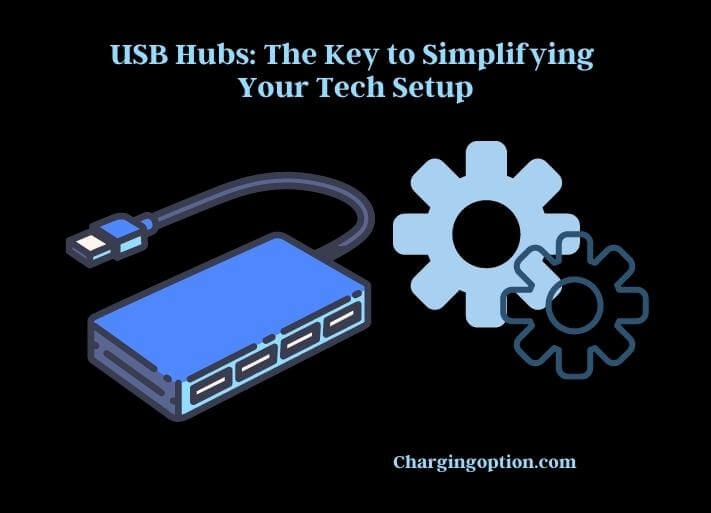
The importance of USB hubs in modern computing cannot be overstated. Without them, users would need to unplug and plug in each device repeatedly, which can be time-consuming and cumbersome. Additionally, the increasing reliance on laptops and other portable devices with limited USB ports makes USB hubs essential for expanding their connectivity capabilities.
What is a USB Hub
A USB hub is a device that allows multiple USB devices to be connected to a single USB port on a computer or other device. It typically has several USB ports on it, which can be used to connect devices such as mice, keyboards, printers, scanners, external hard drives, and other peripherals.
USB hubs come in different sizes and shapes, from small portable models with two or three ports to larger desktop models with multiple ports. Some hubs may also include additional features like charging ports for mobile devices or Ethernet ports for network connectivity.
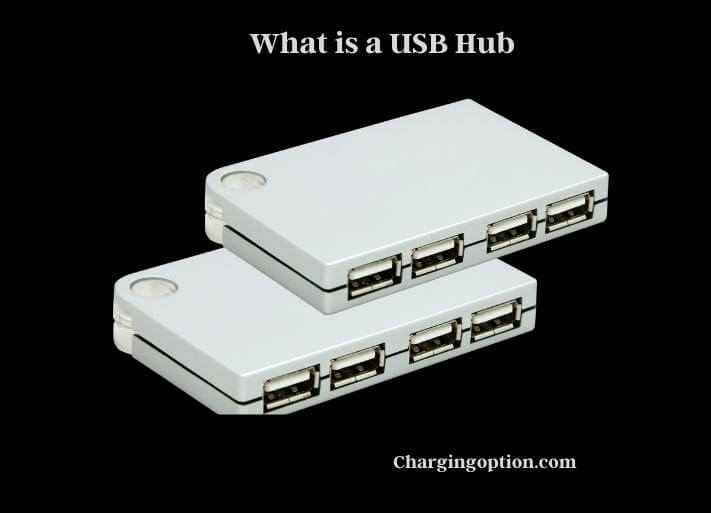
When a USB hub is connected to a computer, it acts as an intermediary between the computer and the connected USB devices, allowing data to be transmitted between them. This can be useful for situations where there are not enough USB ports on a computer, or when multiple devices need to be connected to a single port.
Types of USB Hubs
USB hubs come in different types, each with its own unique features and benefits. Here are the three main types of USB hubs:
Powered USB Hubs
Powered USB hubs require an external power source to provide power to connected devices. This makes them ideal for high-power devices such as external hard drives, scanners, and printers.
Powered USB hubs come with an AC adapter that plugs into an electrical outlet, which provides power to the hub and the connected devices. They offer faster data transfer speeds than unpowered hubs, and they prevent the host computer from being overloaded with power-hungry devices.
Unpowered USB Hubs
Unpowered USB hubs draw power from the host computer, which can result in slower transfer speeds and lower power output. These hubs are suitable for low-power devices such as mice, keyboards, and USB flash drives. However, they may not provide enough power for high-power devices, and connecting too many devices may result in power issues or reduced performance.
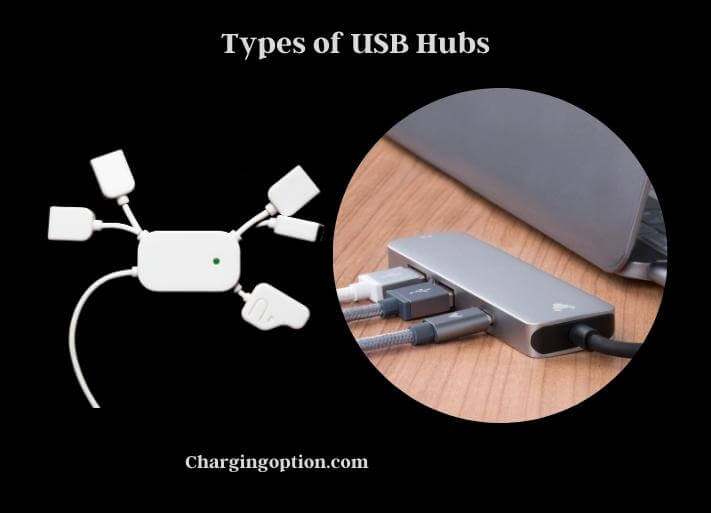
Self-Powered USB Hubs
Self-powered USB hubs have an internal power supply that can power the hub and the connected devices. These hubs are suitable for high-power devices and are a good choice for users who want to connect several power-hungry devices without overloading their computer’s power supply. Self-powered USB hubs come with an AC adapter and offer fast transfer speeds.
Choosing the right type of USB hub depends on the devices you need to connect and the amount of power they require. If you plan to connect high-power devices such as external hard drives, scanners, and printers, a powered USB hub may be the best option.
How USB Hubs Work
A USB hub acts as an intermediary between the host device (typically a computer) and peripheral devices (such as printers, keyboards, and external hard drives). USB hubs have a single upstream port that connects to the host device and multiple downstream ports that connect to peripheral devices. The hub monitors and manages communication between the host device and the connected devices.
When a peripheral device is connected to a USB hub, the hub assigns a unique address to the device and sends it to the host device. The host device recognizes the peripheral device as a new device and begins the process of installing drivers if necessary. Once the device is recognized and installed, the host device can communicate with the peripheral device through the USB hub.
When multiple devices are connected to a USB hub, the hub manages the communication between the host device and the devices to prevent data collisions and ensure that data is transmitted smoothly. This allows users to connect multiple devices to their computers without the need for additional USB ports.
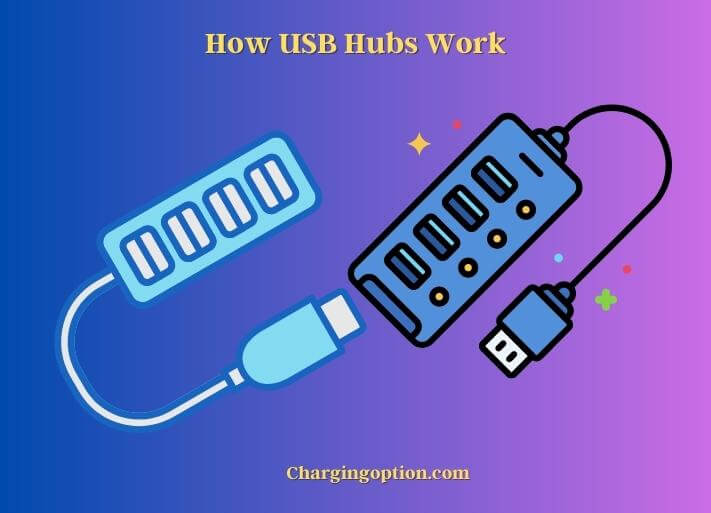
Some USB hubs also have additional features such as LED indicators that show the status of each port, and port switching that allows users to switch between devices without physically unplugging and replugging them.
It’s important to note that the number of devices that can be connected to a USB hub is limited by the number of ports available on the hub, as well as the amount of power that the hub can provide. Overloading a USB hub can lead to reduced performance or power issues, so it’s important to choose a USB hub that meets the power and connectivity needs of the devices being used.
Factors to Consider When Choosing a USB Hub
Choosing the right USB hub can be a daunting task, especially given the variety of options available in the market. Here are some factors to consider when choosing a USB hub:
Number of Ports
The number of ports on a USB hub is an important factor to consider, as it determines the number of devices that can be connected to the hub. If you have several devices that need to be connected to your computer, it’s best to choose a hub with multiple ports.
Type of Ports
The type of ports on the USB hub is another important consideration. USB 2.0 ports are slower than USB 3.0 ports, but they are more widely compatible with older devices. If you have devices that require faster transfer speeds, it’s best to choose a USB hub with USB 3.0 ports.
Power Supply
The power supply of the USB hub is another factor to consider, especially if you plan to connect high-power devices such as external hard drives. A powered USB hub that comes with an AC adapter can provide more power to connected devices than an unpowered USB hub.
Port Arrangement
The arrangement of ports on the USB hub is also an important consideration, especially if you plan to connect large devices such as external hard drives. A hub with horizontally arranged ports may be more convenient than a hub with vertically arranged ports, as it allows for more space between connected devices.
Brand and Quality
The brand and quality of the USB hub is also important consideration. It’s best to choose a reputable brand that offers high-quality products that are built to last. Cheaper USB hubs may be more affordable, but they may not offer the same level of performance and durability as more expensive brands.
Additional Features
Some USB hubs offer additional features such as LED indicators, port switching, and built-in card readers. These features can add convenience and functionality to your setup, but they may also add to the cost of the USB hub.
By considering these factors, you can choose a USB hub that meets your connectivity needs and provides the best value for your money.
Advantages and Disadvantages of USB Hubs
USB hubs have become an essential part of many computer setups, allowing users to connect multiple devices to their computers. Here are some of the advantages and disadvantages of using USB hubs:
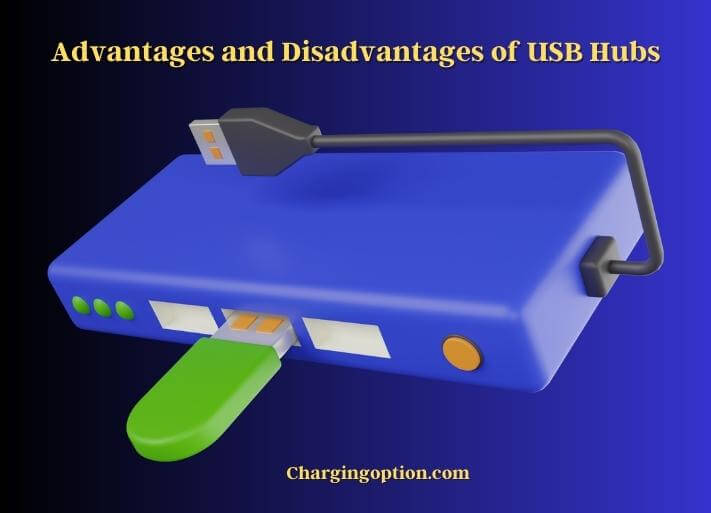
Advantages
Increased connectivity: USB hubs allow users to connect multiple devices to their computers, even if the computer has a limited number of USB ports.
Convenience: USB hubs allow users to plug in and unplug devices without having to reach behind their computers, making it easier to switch between devices.
Portability: USB hubs are often compact and easy to carry around, making them a convenient solution for people who need to connect multiple devices while on the go.
Power options: Powered USB hubs can provide additional power to connected devices, making them a good choice for people who need to connect high-power devices like external hard drives.
Disadvantages
Data transfer speed: If multiple high-bandwidth devices are connected to a USB hub, the data transfer speed may be reduced due to the limited bandwidth of the USB hub.
Power limitations: Some USB hubs do not provide enough power to connected devices, resulting in slow performance or other issues.
Compatibility issues: Some USB hubs may not be compatible with certain devices, especially older devices that require USB 2.0 ports.
Overloading risks: Overloading a USB hub can lead to reduced performance or even damage to the devices being used.
Common Uses of USB Hubs
USB hubs have a variety of uses, both in personal and professional settings. Here are some common uses of USB hubs:
Connecting Multiple Devices
USB hubs allow users to connect multiple devices to their computers, such as external hard drives, printers, scanners, keyboards, and mice. This makes it easier to manage and use multiple devices at the same time.
Charging Devices
USB hubs with charging capabilities can be used to charge multiple devices at once, such as smartphones, tablets, and other portable devices. This is especially useful for people who have multiple devices that require charging.
Gaming Setups
Gaming setups often require multiple devices to be connected to the computer, such as controllers, headsets, and other peripherals. USB hubs can help manage all of these devices and reduce cable clutter.
Home Entertainment
USB hubs can also be used in home entertainment setups to connect devices like media players, streaming devices, and external hard drives. This allows users to access and stream their favorite movies, TV shows, and music.
Photography and Video Editing
USB hubs can be used in photography and video editing setups to connect cameras, external hard drives, and other peripherals. This allows users to transfer files quickly and easily between devices.
Office Settings
In an office setting, USB hubs can be used to connect printers, scanners, and other office equipment to a single computer. This can help reduce clutter and make it easier to manage multiple devices.
Frequently Asked Questions (FAQs)
What Is a USB Hub?
A USB hub is a device that expands a single Universal Serial Bus (USB) port into several, allowing multiple devices to be connected to a single USB port. It’s commonly used when there are not enough USB ports on a computer to connect all desired devices.
Are All USB Hubs the Same?
No, all USB hubs are not the same. There are various types including USB 2.0, USB 3.0, USB 3.1, and USB-C hubs. These versions differ in data transfer speed, power delivery, and the physical design of the plug. It’s important to select a USB hub that matches your devices’ requirements and your computer’s available USB ports.
Can USB Hubs Charge Devices?
Yes, some USB hubs are capable of charging devices. These are usually labeled as “charging hubs”. However, it’s important to note that the charging speed can vary based on the hub’s power output and the device’s requirements. Not all USB hubs are designed with charging in mind, so it’s essential to check the hub’s specifications before purchasing if this feature is important to you.
Do USB Hubs Slow Down Data Transfer Speeds?
USB hubs do not inherently slow down data transfer speeds, but the speed can be affected if multiple devices are transferring data simultaneously. The total bandwidth of the USB hub is shared among all connected devices. Therefore, if you’re transferring data between multiple devices at once, each will have a smaller portion of the bandwidth, and transfers may be slower.
Why Is My USB Hub Not Working?
There could be several reasons why your USB hub is not working. It could be a problem with the hub itself, the USB cable, the connected device, or the USB port on your computer. Check that all connections are secure, the devices are functioning correctly, and the USB hub is getting power, if required. If the hub still isn’t working, it could be a driver issue, which can often be fixed by updating or reinstalling your computer’s USB drivers.
Conclusion
USB hubs are versatile and useful tools that allow users to connect multiple devices to their computers. With different types, sizes, and features available, users can choose a USB hub that suits their specific needs. It’s important to consider factors like data transfer speed, power limitations, and compatibility issues when choosing a USB hub to ensure optimal performance and functionality.
Despite some disadvantages, USB hubs offer many advantages, including increased connectivity, convenience, and portability. Whether you’re using a USB hub for personal or professional use, it can help streamline your setup and make it easier to manage multiple devices.
